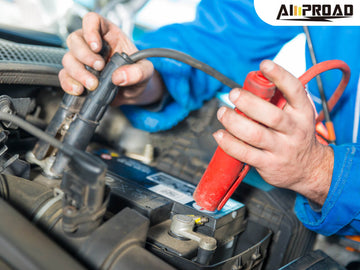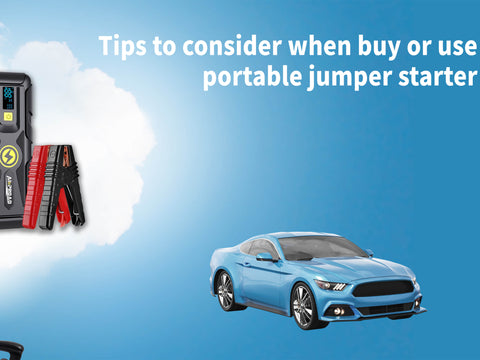
Ever faced a dead battery and a stalled engine, stranded and frustrated? A jump starter can be your knight in shining armor, but choosing the right one can be confusing. Cranking Amps (CCA) is a key factor, but what exactly is it? This guide dives into the world of CCA, explaining how it determines your jump starter's ability to crank your engine back to life. We'll explore how engine size, weather conditions, and even the type of vehicle you drive all influence your CCA needs. By the end, you'll be a jump starter picking pro, ready to choose the perfect one for your next adventure!
What are Cranking Amps (CCA) and how do Cranking Amps relate to engine starting power?
Have you ever been faced with a dead car battery, leaving you stranded and wishing you had a jump starter? But then the question hits: how much power do you actually need? Cranking Amps (CCA) is a critical factor in choosing the right battery booster, but what exactly does it mean?
Cranking Amps (CCA) is a rating system that indicates a battery's ability to deliver a specific amount of current (amps) at a low temperature (usually 0 degrees Fahrenheit) for a set amount of time (typically 30 seconds). In simpler terms, it reflects how much muscle a battery has to overcome the initial resistance in your engine and crank it until it starts.
Let's connect the dots between CCA and engine starting power. When you turn your key, the starter motor essentially acts like a powerful electric motor. It cranks the engine, overcoming the inertia of the pistons, cylinders, and other internal components. This cranking process requires a significant burst of current, which is where your car battery comes in.
Here's where CCA plays a crucial role. A battery with a higher CCA rating can deliver more amps during startup. This translates to more power to crank the engine, especially in challenging conditions like cold weather. Cold temperatures make engine oil thicker and increase resistance, making it harder for the engine to turn. A high CCA jump starter provides the extra oomph needed to overcome this resistance and get your engine going.
So, the next time you're considering a jump starter, remember CCA. It's not just about jump start any car; it's about ensuring your jump starter has the muscle to tackle the specific needs of your engine, especially in less-than-ideal conditions.
Cranking Amp Requirements for Different Vehicles

Now that we understand the role of Cranking Amps (CCA) in jump starting, let's explore how CCA requirements can vary depending on your vehicle:
Do All Vehicles Require the Same Amount of Cranking Amps to Start?
Absolutely not! The CCA needs of your jump starter will depend on several factors specific to your vehicle. Imagine needing to jumpstart a compact car with a tiny engine versus a heavy-duty truck – their starting power requirements will be vastly different.
How Does Engine Size (Displacement) Affect CCA Requirements?
Engine size, often measured in liters or cubic inches (displacement), is a key factor influencing CCA needs. Larger engines with greater displacement naturally have more internal components that need to be cranked. This requires a jump starter with a higher CCA rating to deliver enough amps and overcome the increased resistance. Think of it like needing more muscle to push a heavier object. For instance, a small car with a 1.5-liter engine might only require a booster batterie with 200-300 CCA, while a large SUV with a 5.0-liter engine might need a jump starter with 400-600 CCA or more to ensure a successful jump.
Do Factors Like Weather (Cold/Hot) Influence CCA Needs?
The answer is yes, weather conditions can significantly impact your CCA requirements. As mentioned earlier, cold weather thickens engine oil, increasing the resistance during startup. This means your battery, and consequently your jump starter, needs to work harder to overcome that resistance. In colder climates (think freezing temperatures), a higher CCA jump starter (around 400 CCA or more) is recommended to provide the extra burst of power needed to crank the engine. Conversely, in hot weather, CCA requirements are less stringent. However, extreme heat can still weaken a battery, so a jump starter with a decent CCA rating (around 300 CCA) is still a wise choice.
By understanding how engine size and weather conditions influence CCA needs, you can make an informed choice when selecting a jump starter. Remember, it's always better to err on the side of caution and choose a jump starter with a higher CCA rating. This ensures you have the power needed to tackle various situations, keeping you prepared for unexpected dead batteries, no matter the season.
Selecting the Right CCA for Your Jump Starter

Having explored the factors influencing CCA requirements, let's delve into choosing the right CCA for your jump starter. Selecting a jump starter with the appropriate CCA rating ensures you have the necessary power to tackle dead batteries in various situations.
What Happens if a Jump Starter Has Too Few Cranking Amps?
Opting for a jump starter with a CCA rating too low for your vehicle's needs can lead to a frustrating situation. The jump starter simply might not have enough muscle to overcome the initial resistance in your engine, leaving you stranded. Imagine trying to jumpstart a large SUV with a jump starter meant for a compact car – it likely wouldn't have the necessary amps to crank the engine.
Are There Any Drawbacks to Using a Jump Starter with Too Many Cranking Amps?
While it might seem tempting to go for the highest CCA jump starter on the market, there are a few things to consider. Generally, there's no harm in using a jump starter with a higher CCA rating than your vehicle needs. In fact, a jump starter like the AMPROAD high-quality versatile portable jump starter with a 2000A cranking rate offers ample power for most vehicles, including larger SUVs and trucks. However, these high-powered jump starters tend to be bulkier, heavier, and more expensive compared to their lower CCA counterparts. So, if you primarily drive a small car and prioritize portability, a more compact jump starter with a lower might be a better fit.
How Can I Determine the Recommended CCA for My Specific Vehicle?
There are three main ways to determine the recommended CCA for your vehicle:
- Owner's Manual: Your vehicle's owner's manual is a wealth of information, including the recommended CCA rating for your specific car battery. This is the most reliable and trustworthy source for this information.
- Car Battery Label: The CCA rating is often printed directly on the sticker label of your car battery. Pop the hood and take a look!
- Online Resources: Several online resources and car manufacturer websites allow you to search for recommended CCA ratings by entering your vehicle's make, model, and year.
By considering your engine size, typical weather conditions in your area, and your budget, you can choose a car booster pack with the ideal CCA rating to keep you prepared for unexpected dead battery situations. Remember, a little planning and understanding of CCA can go a long way in ensuring a smooth and successful jumpstart experience.
Additional Considerations for Jump Starter Selection

Cranking Amps (CCA) are crucial for jump starter selection, but they're not the only factor to consider. Here are some additional features that can influence your choice:
- Peak Amps: While CCA indicates a jump starter's ability to deliver sustained current over a short period, peak amps represent a momentary surge of power. This surge can be helpful in overcoming stubborn dead batteries, especially in very cold weather. Look for a jump starter with a peak amp rating that's at least double the CCA rating.
- Portability: Jump starters come in various sizes and weights. If you prioritize easy storage and transportation in your trunk, a compact and lightweight jump starter might be ideal. However, these often have lower CCA ratings. Conversely, larger jump starters with higher CCA ratings might be bulkier and heavier but offer more power for tackling a wider range of vehicles.
- Safety Features: Look for a jump starter with built-in safety features like reverse polarity protection. This safeguards against accidental damage if the jumper cables are connected incorrectly. Automatic shut-off features in case of overheating or overloading are also valuable additions.
- Extra Features: Some jump starters offer additional functionalities like USB ports for charging smartphones or tablets, LED flashlights for emergency illumination, and even built-in air compressors for topping off deflated tires. While not essential for jump starting, these features can add versatility to your roadside emergency kit.
Putting it All Together:
When choosing a jump starter, consider your vehicle's needs (engine size, typical weather conditions) and your own priorities (portability, budget). For instance, as per the research on Battery University, if you drive a small car and live in a temperate climate, a compact jump starter with a 300-400 CCA rating might be sufficient (1.0-2.0L). However, if you own a large SUV and live in a region with harsh winters, a jump starter with a higher CCA rating (around 500 CCA or more) and a strong peak amp rating would be a wise choice. Remember, a jump starter like the AMPROAD high-quality versatile portable jump starter offers ample power for most vehicles, but there are other factors to consider beyond just CCA.
By understanding these factors and carefully selecting a jump starter, you'll be well-equipped to acquire the knowledge for how to boost a car back to life in the event of a dead battery, ensuring a smooth journey and avoiding roadside frustration.
Related articles:
How to jumpstart a car with cables?
How to clean car battery corrosion?



